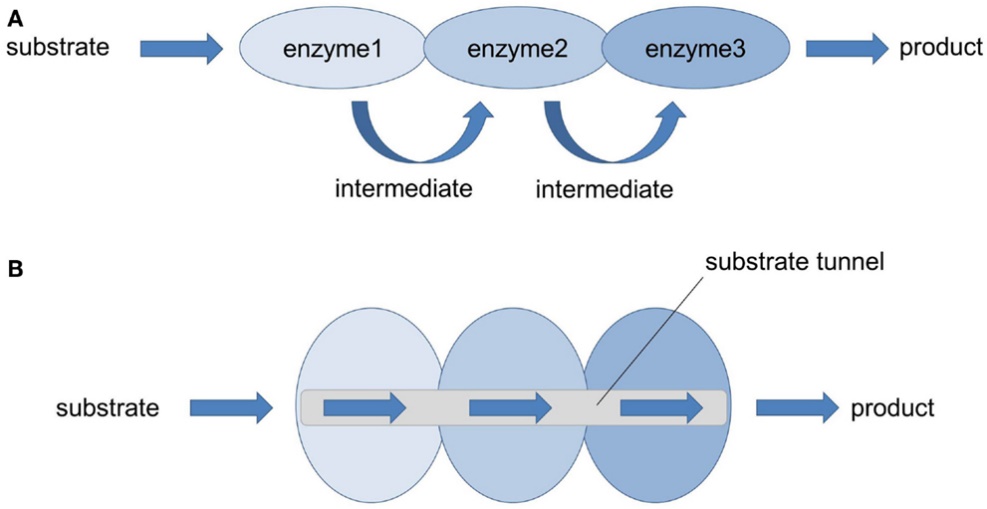A New Platform of Biosynthesis for Industrial Production
Multi-Enzyme Complex
Cells in biological reactions carry out thousands of chemical reactions all the time. To ensure the efficient and orderly progress of the responses, the enzymes that catalyze multistep reactions in nature do exist free but form as multi-enzyme complexes. The multi-enzyme complex is formed by polymerizing several enzymes of different functions with each other. Multi-enzyme complex generally includes three or more enzymes that combine a certain structure configuration. In nature, cells have formed multi-enzyme complexes through a long evolution. In a continuous reaction system, the product of the previous reaction is the substrate of the following reaction. The reactions are connected in sequence to form a metabolic pathway or a part of a metabolic pathway. In Science, the sequence of reactions is carried out in a highly ordered multi-enzyme complex. The enzyme's catalytic efficiency is improved, and the regulation of the enzyme is facilitated. Many multi-enzyme systems in intact cells are capable of self-regulation. In these complexes, substrate channels can be formed between enzymes to reduce the diffusion of intermediates to achieve interesting intracellular catalysis and metabolism in cells which play an essential role in life activities.
 Fig.1 Multi-Enzyme Complex
Fig.1 Multi-Enzyme Complex
Self-Assembling Multi-Enzyme Complex
Simulating natural multi-enzyme complexes and artificially constructing supramolecular multi-enzymes in cells is an important research direction in biocatalysts and synthetic biology. Therefore, simulating and constructing multi-enzyme complexes has received increasing attention from the scientific and industrial communities. However, efforts to engineer new functional biosynthetic pathways in well-characterized micro-organisms such as E. Coli are still often hampered by imbalanced pathway flux, formation of side products, and accumulation of toxic intermediates that can inhibit host cell growth.
Recently, researchers have invented a new platform of biosynthesis for industrial production which is based on a DNA scaffold-assisted assembly of metabolic pathways in the E. coli system, that can generate an artificial complex of metabolic pathway enzymes that uses DNA as the scaffold. In this new platform, a synthetic nucleic acid scaffold comprises one or more subunits; each consists of two or more different protein-binding sequences. The researchers demonstrated this system as a viable strategy for significantly enhancing the titers of three various metabolic products. In the case tested by the researchers, DNA scaffold-assisted biosynthesis was implemented on an existing microbial metabolic pathway. It did not require any a priori knowledge about any underlying biosynthetic enzymes; implementing this new approach is generalizable and straightforward to virtually any pathway.
Advantages
- This system has the potential for arranging enzymes into a predefined order based on the highly predictable local structure of DNA.
- Compared with protein- and RNA- based scaffolds, the stability of DNA scaffolds is largely sequence-independent and reduces the rate of misfolding, aggregation, and susceptibility to degradation.
- A larger number numbers of different DNA-binding proteins exist in nature.
Potential Applications
- Industrial production and research use.
- For optimizing and fine-tuning metabolic flux in vivo.
- Useful in sequestering different types of enzymes for specifying the output of biological signaling pathways or for coordinating other assembly-line processes.
- Applications in protein folding, degradation, and modification.
Profacgen is a company dedicated to research in the biological field. We have been committed to discovering advanced experimental techniques to provide stronger support for our customers' research. Please do not hesitate to contact us for more details if you are interested in this new method, and we will provide considerate service for you. At the same time, we also offer other services, please move to our website for more details on protein-protein interaction.
Reference
- Proschel M, Detsch R, Boccaccini AR, Sonnewald U. Engineering of Metabolic Pathways by Artificial Enzyme Channels. Front Bioeng Biotechnol. 2015, 3:168. doi:10.3389/fbioe.2015.00168.
Fill out this form and one of our experts will respond to you within one business day.